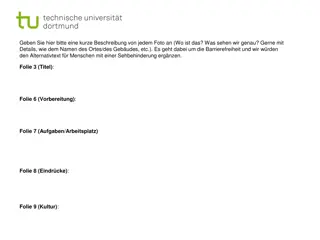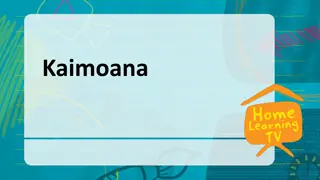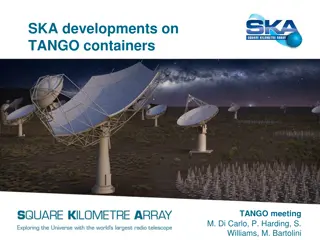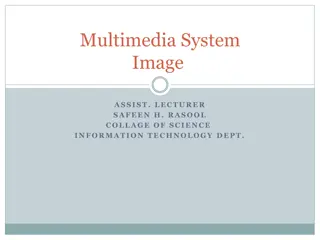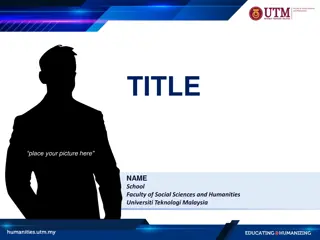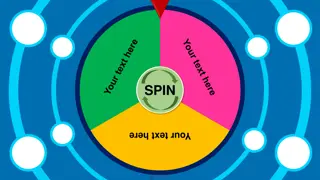
Measurements and Design Choices in Video Telephony
Explore the intricacies of video telephony through a measurement study of Google+, iChat, and Skype. Uncover the challenges in video conferencing, key design choices, system architectures, packet loss recovery, and user Quality-of-Experience considerations. Dive deep into the technologies enabling real-time audio-video communication across different locations, emphasizing the importance of high-bandwidth and low-delay data transmissions for optimal user experience.
Download Presentation

Please find below an Image/Link to download the presentation.
The content on the website is provided AS IS for your information and personal use only. It may not be sold, licensed, or shared on other websites without obtaining consent from the author. If you encounter any issues during the download, it is possible that the publisher has removed the file from their server.
You are allowed to download the files provided on this website for personal or commercial use, subject to the condition that they are used lawfully. All files are the property of their respective owners.
The content on the website is provided AS IS for your information and personal use only. It may not be sold, licensed, or shared on other websites without obtaining consent from the author.
E N D
Presentation Transcript
VIDEO TELEPHONY FOR END VIDEO TELEPHONY FOR END- -CONSUMERS: MEASUREMENT STUDY OF GOOGLE+, ICHAT, AND SKYPE MEASUREMENT STUDY OF GOOGLE+, ICHAT, AND SKYPE CONSUMERS: YANG XU, CHENGUANG YU, JINGJIANG LI AND YONG LIU DEPARTMENT OF ELECTRICAL AND COMPUTER ENGINEERING POLYTECHNIC INSTITUTE OF NEW YORK UNIVERSITY
What is Video telephony ? Ans: Video telephony comprises the technologies for the reception and transmission of audio-video signals by users at different locations, for communication between people in real-time Video telephony requires high-bandwidth and low-delay data transmissions between users Main challenge for video conference: 1.different user device and network access 2.dynamic bandwidth variation 3.random network impairments like packet loss or delay This paper unveil 4 major design choice of 3 different systems,we will see them later
systems key design choice 1.System Architecture : I . natural method is Peer-to-Peer (P2P),but user normally cannot upload multiple high-quality video streams simultaneously. II . video conferencing servers can be employed to relay users voice and video. 2.Video Generation and Adaptation : I.single video version-downloadable by the weakest receiver. II.multiple video versions-match receiver s download capacity , but High encoding and bandwidth overhead. III. Scalable Video Coding(SVC) - encodes video into multiple layers,can reduce overhead
SYSTEMS KEY DESIGN CHOICES(CONT.) 3.Packet Loss Recovery : I.Forward Error Correction (FEC) for real-time system , FEC block must be short , it will reduce coding efficiency II.retansmission viable if network delay is small , retransmission add redundancy only as needed, and hence is more bandwidth-efficiency 4.User Quality-of-Experience (QoE): consider voice&video delay, synchronization , video resolution, frame-rate and quantization, etc. Most Important is adaptive to varying network conditions and robust against random network impairments
SYSTEM ARCHITECTURE SYSTEM ARCHITECTURE They use 3 stage of experiment to identify voice, video, and signaling flows- 1.Normal conference 2.Only voice conference 3. No one of them I.iChat : P2P ,star topology,only central hub (initator) can add or close the conference. upload data flow use only UDP flow , RTP protocol II.Coogle+: Server-centric topology,not direct transmission by user ,but by proxy servers. data flow use UDP flow Most time ,TCP is used only UDP is taffic.it also use RTP protocol.
SYSTEM SYSTEM ARCHITECTURE(CONT.) ARCHITECTURE(CONT.) III.Skype : Hyprid topology,in two-party calls use direct P2P; if more user ,like picture .voice flow transport like iChat(initiator do sound mix to combine user voice to one stream);for video flow , user upload to server which directly relays to other reciver. Skype use UDP and TCP flow,but not use RTP protocol
They try to find conference server placement use geolocation tool - Maxmind,and found : 1.Google+ servers are assigned to nearest to client around the world. 2.Skype server are all have same subnet address ,after try to ping them all located on the same place,near New Jersey
VIDEO GENERATION AND ADAPTATION video quality is mostly determined by three video encoding parameters: resolution, frame rate, and quantization. Skype and Google+ adapt video resolution to network bandwidth; iChat s video resolution is determined by the number of users in the conference. I.Chat uses One-version Encoding. II.Skype uses Multi-version Encoding : source-side multi-version encoding, if sender or receiver capacity are low use one-version. III. Google+ uses Multi-layer Encoding
VIDEO GENERATION AND ADAPTATION(CONT.) For RTP packet header format: Sequence Number(packet number),Timestamp(first sampling time of packet), Marker(last packet is 1) Check For reciver 1, Google+ achieve temporal scalability reciver 2, Google+ achieve spatial scalability Temporal scalability:
VOICE AND VIDEO DELAY VOICE AND VIDEO DELAY Define Te : the voice/video capturing and encoding delay at the sender Tn: be the one-way transmission and propagation delay on the network path Ts :be the server or super-node processing time (Ts = 0, if there is no server or super-node involved) Td :be the video or voice decoding and playback delay at the receiver. one-way voice (video) delay is: T = Te + Tn + Ts + Td.
ONE-WAY VOICE & VIDEO DELAY 1.Use OCR software to recognize image 2.Round-trip time 3.one-way delay 4.Google+ use most time to process data 5.Skype in two party is faster than multi party 6.Skype s video & voice is unsynchronized 7.Round-trip video delay (RTT)
For RTT Google+ is faster than Skype. The transmission between Google+ relay servers likely traverse their own private backbone network with good QoS guarantee. Google+ system incur less network loss and delay than Skype.
ROBUSTNESS AGAINST LOSSES ROBUSTNESS AGAINST LOSSES Conventional wisdom is to use packet-level forward error correction (FEC) coding. But if network delay is short enough(20ms),retansmission is affordable. Skype employs aggressive FEC coding for VoIP(Voice over IP) and two-party video conference. Define FEC redundancy ratio
recovery ratio is defined as the fraction of lost packets that are eventually received by the receiver. persistent ratio defines the fraction of packets retransmitted at least once that are eventually received by the receiver. Google+ applies selective persistent retransmission to packets of the lower video layers first. define the k-th retransmission interval as the time lag between the kth retransmission and the (k 1)th retransmission of the same packet
layered video coding not only adapts to user heterogeneity well, but also enhances video quality resilience against losses.
Skypes FEC efficiency is almost independent of RTT. FEC is preferable over retransmissions if RTT is large, loss is random, and loss rate is not too high.
CONCLUSION pure P2P architecture cannot sustain high-quality multi-party video conferencing services on the Internet. bandwidth-rich server infrastructure can be deployed to significantly improve user conferencing experiences. Compared with multi-version video coding, layered video coding can more efficiently address user access heterogeneity. With layered video coding, prioritized selective retransmissions can further enhance the robustness of conferencing quality against various network impairments.


